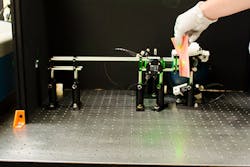University of Missouri team develops combination laser/ultrasound tattoo-removal technique
The first laser treatments used to treat skin conditions such as benign vascular birthmarks and port-wine stains were developed more than 40 years ago. Since then, clinicians and dermatologists have seen a rise in demand for minimally invasive laser-based treatments, including tattoo removal. However, it is difficult for the laser light, which is held at a distance from the skin, to be perfectly and selectively absorbed by only the targeted birthmark or tattoo.
Now, researchers from the University of Missouri (MU; Columbia, MO) have developed instruments that transmit laser light into the tissue through direct contact. The techniques developed by the interdisciplinary team can be used by dermatologists and will reduce safety concerns in laser dermatology by improving laser transmission through surface layers of the skin.
Laser techniques come with risks, including eye damage. Open-air transmission, in which the clinician holds the laser at a distance from the patient, is typical during normal dermatological procedures and presents a hazard to both the patients' and doctors' eyes. Paul Whiteside, a doctoral candidate in the MU Division of Food Systems and Bioengineering, devised a system that will not only improve the process, but will be safer for both clinicians and patients.
"The system we developed uses ultrasonic pulsation in conjunction with a clinical laser to alter the properties of skin tissues during the procedure," Whiteside says. "We've named the technique 'sonoillumination,' and we're hopeful that the procedure will be available widely in the near future."
Whiteside and his team, including adviser, Heather Hunt, an assistant professor of bioengineering in the MU College of Engineering, tested the sonoillumination system on porcine skin-tissue samples. Using various amplitudes and pulses, the instruments they developed were tested on the samples and showed great promise for the clinical setting. Whiteside presented his technique to clinicians on April 9, 2017, at the annual conference of American Society for Laser Medicine and Surgery (ASLMS; San Diego, CA).
The team co-authored the paper "Ultrasonic modulation of tissue optical properties in ex vivo porcine skin to improve transmitted transdermal laser intensity," which recently was accepted for publication by the society's journal, Lasers in Surgery and Medicine.
The researchers are developing a startup company to commercialize the technique.

John Wallace | Senior Technical Editor (1998-2022)
John Wallace was with Laser Focus World for nearly 25 years, retiring in late June 2022. He obtained a bachelor's degree in mechanical engineering and physics at Rutgers University and a master's in optical engineering at the University of Rochester. Before becoming an editor, John worked as an engineer at RCA, Exxon, Eastman Kodak, and GCA Corporation.
